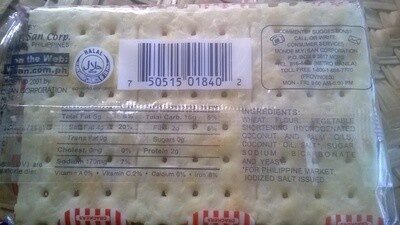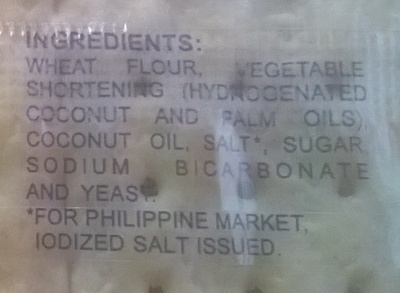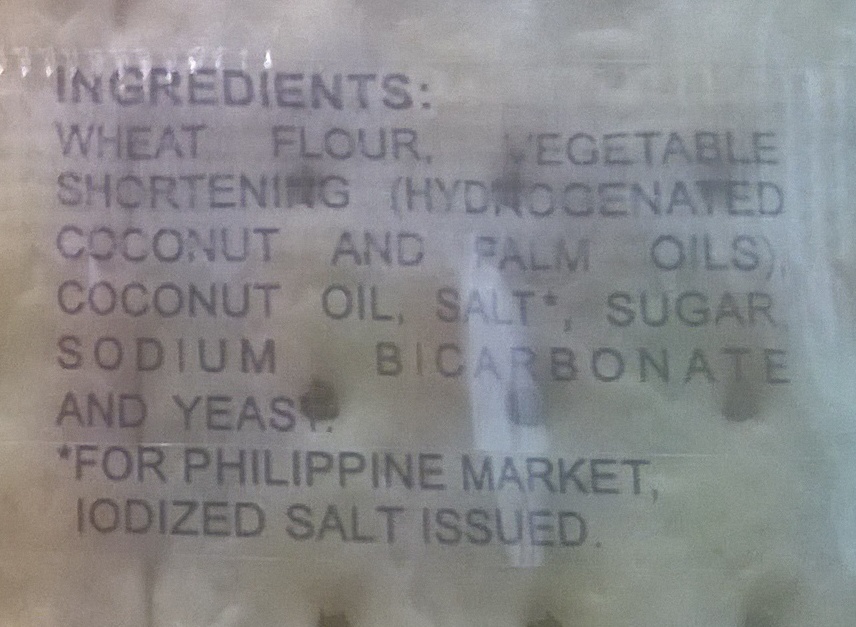Help us make food transparency the norm!
As a non-profit organization, we depend on your donations to continue informing consumers around the world about what they eat.
The food revolution starts with you!
SkyFlakes Crackers - M. Y. San - 3 crackers (25 g)
SkyFlakes Crackers - M. Y. San - 3 crackers (25 g)
Ang pahina ng produkto ay hindi kumpleto. Makakatulong ka sa pagkompleto nito sa pamamagitan ng pag-edit at pagdagdag ng higit pang data mula sa mga larawan na mayroon kami, o sa pamamagitan ng pagkuha ng larawan gamit ang app sa Android or iPhone/iPad. Salamat!
×
Barcode: 0750515018402 (EAN / EAN-13) 750515018402 (UPC / UPC-A)
Karaniwang pangalan: Crackers
Kandidad: 3 crackers (25 g)
Balot: en:Plastic
Mga tatak: M. Y. San, SkyFlakes
Mga kategorya: en:Snacks, en:Salty snacks, en:Appetizers, en:Crackers
Mga tanda, mga sertipikasyon, mga parangal:
Halal
Origin of the product and/or its ingredients: Product of the Philippines
Mga lugar sa paggawa o pagproseso: Philippines
Mga bansa kung saan ibinebenta: Pilipinas
Matching with your preferences
Health
Mga Sangkap
-
12 ingredients
Wikang Ingles: WHEAT FLOUR, COCONUT OIL, VEGETABLE SHORTENING (COCONUT OIL, PALM OIL AND VITAMIN E (ANTIOXIDANT)), IODIZED SALT, SUGAR, SODIUM BICARBONATE (RAISING AGENT), YEASTMga allergen: en:GlutenMga bakas: en:Milk, en:Soybeans, en:Sulphur dioxide and sulphites
Food processing
-
Processed foods
Elements that indicate the product is in the en:3 - Processed foods group:
- Kategorya: Salty snacks
- Sangkap: Asin
- Sangkap: Asukal
- Sangkap: Vegetable fat
- Sangkap: Vegetable oil
Food products are classified into 4 groups according to their degree of processing:
- Unprocessed or minimally processed foods
- Processed culinary ingredients
- Processed foods
- Ultra processed foods
The determination of the group is based on the category of the product and on the ingredients it contains.
Mga sangkap
-
E500
Sodium carbonate: Sodium carbonate, Na2CO3, -also known as washing soda, soda ash and soda crystals, and in the monohydrate form as crystal carbonate- is the water-soluble sodium salt of carbonic acid. It most commonly occurs as a crystalline decahydrate, which readily effloresces to form a white powder, the monohydrate. Pure sodium carbonate is a white, odorless powder that is hygroscopic -absorbs moisture from the air-. It has a strongly alkaline taste, and forms a moderately basic solution in water. Sodium carbonate is well known domestically for its everyday use as a water softener. Historically it was extracted from the ashes of plants growing in sodium-rich soils, such as vegetation from the Middle East, kelp from Scotland and seaweed from Spain. Because the ashes of these sodium-rich plants were noticeably different from ashes of timber -used to create potash-, they became known as "soda ash". It is synthetically produced in large quantities from salt -sodium chloride- and limestone by a method known as the Solvay process. The manufacture of glass is one of the most important uses of sodium carbonate. Sodium carbonate acts as a flux for silica, lowering the melting point of the mixture to something achievable without special materials. This "soda glass" is mildly water-soluble, so some calcium carbonate is added to the melt mixture to make the glass produced insoluble. This type of glass is known as soda lime glass: "soda" for the sodium carbonate and "lime" for the calcium carbonate. Soda lime glass has been the most common form of glass for centuries. Sodium carbonate is also used as a relatively strong base in various settings. For example, it is used as a pH regulator to maintain stable alkaline conditions necessary for the action of the majority of photographic film developing agents. It acts as an alkali because when dissolved in water, it dissociates into the weak acid: carbonic acid and the strong alkali: sodium hydroxide. This gives sodium carbonate in solution the ability to attack metals such as aluminium with the release of hydrogen gas.It is a common additive in swimming pools used to raise the pH which can be lowered by chlorine tablets and other additives which contain acids. In cooking, it is sometimes used in place of sodium hydroxide for lyeing, especially with German pretzels and lye rolls. These dishes are treated with a solution of an alkaline substance to change the pH of the surface of the food and improve browning. In taxidermy, sodium carbonate added to boiling water will remove flesh from the bones of animal carcasses for trophy mounting or educational display. In chemistry, it is often used as an electrolyte. Electrolytes are usually salt-based, and sodium carbonate acts as a very good conductor in the process of electrolysis. In addition, unlike chloride ions, which form chlorine gas, carbonate ions are not corrosive to the anodes. It is also used as a primary standard for acid-base titrations because it is solid and air-stable, making it easy to weigh accurately.Source: Wikipedia (Wikang Ingles)
-
E500ii
Sodium carbonate: Sodium carbonate, Na2CO3, -also known as washing soda, soda ash and soda crystals, and in the monohydrate form as crystal carbonate- is the water-soluble sodium salt of carbonic acid. It most commonly occurs as a crystalline decahydrate, which readily effloresces to form a white powder, the monohydrate. Pure sodium carbonate is a white, odorless powder that is hygroscopic -absorbs moisture from the air-. It has a strongly alkaline taste, and forms a moderately basic solution in water. Sodium carbonate is well known domestically for its everyday use as a water softener. Historically it was extracted from the ashes of plants growing in sodium-rich soils, such as vegetation from the Middle East, kelp from Scotland and seaweed from Spain. Because the ashes of these sodium-rich plants were noticeably different from ashes of timber -used to create potash-, they became known as "soda ash". It is synthetically produced in large quantities from salt -sodium chloride- and limestone by a method known as the Solvay process. The manufacture of glass is one of the most important uses of sodium carbonate. Sodium carbonate acts as a flux for silica, lowering the melting point of the mixture to something achievable without special materials. This "soda glass" is mildly water-soluble, so some calcium carbonate is added to the melt mixture to make the glass produced insoluble. This type of glass is known as soda lime glass: "soda" for the sodium carbonate and "lime" for the calcium carbonate. Soda lime glass has been the most common form of glass for centuries. Sodium carbonate is also used as a relatively strong base in various settings. For example, it is used as a pH regulator to maintain stable alkaline conditions necessary for the action of the majority of photographic film developing agents. It acts as an alkali because when dissolved in water, it dissociates into the weak acid: carbonic acid and the strong alkali: sodium hydroxide. This gives sodium carbonate in solution the ability to attack metals such as aluminium with the release of hydrogen gas.It is a common additive in swimming pools used to raise the pH which can be lowered by chlorine tablets and other additives which contain acids. In cooking, it is sometimes used in place of sodium hydroxide for lyeing, especially with German pretzels and lye rolls. These dishes are treated with a solution of an alkaline substance to change the pH of the surface of the food and improve browning. In taxidermy, sodium carbonate added to boiling water will remove flesh from the bones of animal carcasses for trophy mounting or educational display. In chemistry, it is often used as an electrolyte. Electrolytes are usually salt-based, and sodium carbonate acts as a very good conductor in the process of electrolysis. In addition, unlike chloride ions, which form chlorine gas, carbonate ions are not corrosive to the anodes. It is also used as a primary standard for acid-base titrations because it is solid and air-stable, making it easy to weigh accurately.Source: Wikipedia (Wikang Ingles)
Pagsusuri ng sangkap
-
en:Palm oil
Ingredients that contain palm oil: en:Palm oil
-
en:Vegan status unknown
Unrecognized ingredients: en:Vitamin E
-
en:Vegetarian status unknown
Unrecognized ingredients: en:Vitamin E
-
Details of the analysis of the ingredients
en: _WHEAT_ FLOUR, COCONUT OIL, VEGETABLE SHORTENING (COCONUT OIL, PALM OIL, VITAMIN E (ANTIOXIDANT)), IODIZED SALT, SUGAR, SODIUM BICARBONATE (RAISING AGENT), YEAST- _WHEAT_ FLOUR -> en:wheat-flour - vegan: yes - vegetarian: yes - ciqual_proxy_food_code: 9410 - percent_min: 14.2857142857143 - percent_max: 100
- COCONUT OIL -> en:coconut-oil - vegan: yes - vegetarian: yes - from_palm_oil: no - ciqual_food_code: 16040 - percent_min: 0 - percent_max: 50
- VEGETABLE SHORTENING -> en:vegetable-fat - vegan: yes - vegetarian: yes - from_palm_oil: maybe - percent_min: 0 - percent_max: 33.3333333333333
- COCONUT OIL -> en:coconut-oil - vegan: yes - vegetarian: yes - from_palm_oil: no - ciqual_food_code: 16040 - percent_min: 0 - percent_max: 33.3333333333333
- PALM OIL -> en:palm-oil - vegan: yes - vegetarian: yes - from_palm_oil: yes - ciqual_food_code: 16129 - percent_min: 0 - percent_max: 16.6666666666667
- VITAMIN E -> en:vitamin-e - percent_min: 0 - percent_max: 11.1111111111111
- ANTIOXIDANT -> en:antioxidant - percent_min: 0 - percent_max: 11.1111111111111
- IODIZED SALT -> en:iodised-salt - vegan: yes - vegetarian: yes - ciqual_food_code: 11058 - percent_min: 0 - percent_max: 1.12
- SUGAR -> en:sugar - vegan: yes - vegetarian: yes - ciqual_proxy_food_code: 31016 - percent_min: 0 - percent_max: 1.12
- SODIUM BICARBONATE -> en:e500ii - vegan: yes - vegetarian: yes - percent_min: 0 - percent_max: 1.12
- RAISING AGENT -> en:raising-agent - percent_min: 0 - percent_max: 1.12
- YEAST -> en:yeast - vegan: yes - vegetarian: yes - percent_min: 0 - percent_max: 1.12
Nutrisyon
-
Poor nutritional quality
⚠ ️Warning: the amount of fruits, vegetables and nuts is not specified on the label, it was estimated from the list of ingredients: 0This product is not considered a beverage for the calculation of the Nutri-Score.
Positive points: 4
- Mga Protina: 5 / 5 (halaga: 12, rounded value: 12)
- Fiber: 4 / 5 (halaga: 4, rounded value: 4)
- Fruits, vegetables, nuts, and colza/walnut/olive oils: 0 / 5 (halaga: 0, rounded value: 0)
Negative points: 21
- Inirhiya: 6 / 10 (halaga: 2060, rounded value: 2060)
- Mga asukal: 1 / 10 (halaga: 8, rounded value: 8)
- Saturated na taba: 10 / 10 (halaga: 16, rounded value: 16)
- Sodium: 4 / 10 (halaga: 448, rounded value: 448)
The points for proteins are not counted because the negative points are greater or equal to 11.
Nutritional score: (21 - 4)
Nutri-Score:
-
Mga antas ng sustansya
-
Fat sa katamtaman ang dami (20%)
What you need to know- A high consumption of fat, especially saturated fats, can raise cholesterol, which increases the risk of heart diseases.
Recommendation: Limit the consumption of fat and saturated fat- Choose products with lower fat and saturated fat content.
-
Saturated fat sa malaking kandidad (16%)
What you need to know- A high consumption of fat, especially saturated fats, can raise cholesterol, which increases the risk of heart diseases.
Recommendation: Limit the consumption of fat and saturated fat- Choose products with lower fat and saturated fat content.
-
Asukal sa katamtaman ang dami (8%)
What you need to know- A high consumption of sugar can cause weight gain and tooth decay. It also augments the risk of type 2 diabetes and cardio-vascular diseases.
Recommendation: Limit the consumption of sugar and sugary drinks- Sugary drinks (such as sodas, fruit beverages, and fruit juices and nectars) should be limited as much as possible (no more than 1 glass a day).
- Choose products with lower sugar content and reduce the consumption of products with added sugars.
-
Asin sa katamtaman ang dami (1.12%)
What you need to know- A high consumption of salt (or sodium) can cause raised blood pressure, which can increase the risk of heart disease and stroke.
- Many people who have high blood pressure do not know it, as there are often no symptoms.
- Most people consume too much salt (on average 9 to 12 grams per day), around twice the recommended maximum level of intake.
Recommendation: Limit the consumption of salt and salted food- Reduce the quantity of salt used when cooking, and don't salt again at the table.
- Limit the consumption of salty snacks and choose products with lower salt content.
-
-
Mga katotohanan ng Nutrisyon
Mga katotohanan ng Nutrisyon As sold
para sa 100 g / 100 mlAs sold
bawat serving (3 crackers (25 g))Compared to: en:Appetizers Enerhiya 2,060 kj
(492 kcal)514.632 kj
(123 kcal)+4% Energy from fat 768 kj
(184 kcal)192 kj
(46 kcal)Fat 20 g 5 g -19% Saturated fat 16 g 4 g +29% Trans fat 0 g 0 g -100% Kolesterol 0 mg 0 mg Carbohydrates 68 g 17 g +26% Asukal 8 g 2 g +60% Fiber 4 g 1 g +98% Protina 12 g 3 g +114% Asin 1.12 g 0.28 g -8% Vitamin A 59.3 µg 14.82 µg Bitamina C 0 mg 0 mg Kalsiyo 22.8 mg 5.7 mg Bakal 5.2 mg 1.3 mg +240% Fruits‚ vegetables‚ nuts and rapeseed‚ walnut and olive oils (estimate from ingredients list analysis) 0 % 0 %
Kapaligiran
-
Eco-Score B - Low environmental impact
⚠ ️The full impact of transportation to your country is currently unknown.The Eco-Score is an experimental score that summarizes the environmental impacts of food products.→ The Eco-Score was initially developped for France and it is being extended to other European countries. The Eco-Score formula is subject to change as it is regularly improved to make it more precise and better suited to each country.Life cycle analysis
-
Average impact of products of the same category: A (Score: 87/100)
Kategorya: Salty snacks, crackers, plain
Kategorya: Salty snacks, crackers, plain
- PEF environmental score: 0.22 (the lower the score, the lower the impact)
- including impact on climate change: 1.59 kg CO2 eq/kg of product
Stage Impact Agriculture
59.7 %Processing
22.4 %Balot
10.6 %Transportation
5.2 %Distribution
2.2 %Consumption
0.0 %
Bonuses and maluses
-
Missing origins of ingredients information
Malus:
⚠ ️ The origins of the ingredients of this product are not indicated.
If they are indicated on the packaging, you can modify the product sheet and add them.
If you are the manufacturer of this product, you can send us the information with our free platform for producers.
-
Ingredients that threatens species
Malus: -10
Contains palm oil
Tropical forests in Asia, Africa and Latin America are destroyed to create and expand oil palm tree plantations. The deforestation contributes to climate change, and it endangers species such as the orangutan, the pigmy elephant and the Sumatran rhino.
-
Packaging with a medium impact
Malus: -10
Shape Material Recycling Impact 1 Packaging Plastic Mataas
Eco-Score for this product
-
Impact for this product: B (Score: 62/100)
Produkto: SkyFlakes Crackers - M. Y. San - 3 crackers (25 g)
Life cycle analysis score: 87
Sum of bonuses and maluses: -20
Final score: 62/100
-
Carbon footprint
-
Equal to driving 0.8 km in a petrol car
159 g CO² per 100g of product
The carbon emission figure comes from ADEME's Agribalyse database, for the category: Salty snacks, crackers, plain (Source: ADEME Agribalyse Database)
Stage Impact Agriculture
53.6 %Processing
18.8 %Balot
17.7 %Transportation
8.7 %Distribution
1.2 %Consumption
0.0 %
Balot
-
Packaging with a medium impact
-
Packaging parts
1 x Packaging 25 g (Plastic)
-
Packaging materials
Material % Packaging weight Packaging weight per 100 g of product Plastic
-
Transportation
-
Origins of ingredients
Missing origins of ingredients information
⚠ ️ The origins of the ingredients of this product are not indicated.
If they are indicated on the packaging, you can modify the product sheet and add them.
If you are the manufacturer of this product, you can send us the information with our free platform for producers.Add the origins of ingredients for this product Add the origins of ingredients for this product
Threatened species
-
Contains palm oil
Drives deforestation and threatens species such as the orangutan
Tropical forests in Asia, Africa and Latin America are destroyed to create and expand oil palm tree plantations. The deforestation contributes to climate change, and it endangers species such as the orangutan, the pigmy elephant and the Sumatran rhino.
Report a problem
-
Incomplete or incorrect information?
Category, labels, ingredients, allergens, nutritional information, photos etc.
If the information does not match the information on the packaging, please complete or correct it. Open Food Facts is a collaborative database, and every contribution is useful for all.
Data sources
Produkto idinagdag sa sa pamamagitan ng andreideleon
Huling pag-edit ng pahina ng produkto sa pamamagitan ng jazzed-pineda.
Pahina ng produkto ay na-edit din ni fix-serving-size-bot, foodless, harragastudios, kiliweb, packbot, quentinbrd, tacite, teolemon, upcbot, xchaosx, yuka.VEpncEFKa2NtS01RaC9NaTJSN2NwTXdsOW9hdkRXU21JdVFWSWc9PQ, yuka.sY2b0xO6T85zoF3NwEKvlldOevCAuD3ONDDjn2yh3_GQI4fvetFvxNKqLag.










